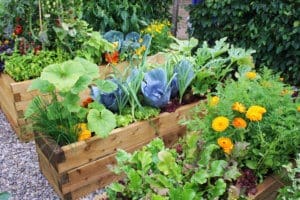 As you’re planning your backyard paradise, one feature many homeowners desire is an edible vegetable garden. Here are a few simple tips to help you properly establish a successful vegetable bed amongst your hardscape design.
As you’re planning your backyard paradise, one feature many homeowners desire is an edible vegetable garden. Here are a few simple tips to help you properly establish a successful vegetable bed amongst your hardscape design.
- Placement. Consider the best place in your yard to establish your garden. You’ll want to make sure it has the right amount of sunlight, the location has access to water, and it is placed where you will enjoy viewing it (or not.) Creating a meandering path to the garden is a nice touch, but make sure you will have a good way to get to your garden with a wheelbarrow and tools.
- Prepare the ground. Regardless of whether you will border your garden with stones or build up a raised bed, you’ll need to remove any grass in the area of your garden. The best way to handle this is to either use a turf-removing tool and sheer off the layer of grass, or place a plastic tarp (“sheet mulching”) over the area for months ahead of time to kill the grass and then scrape off the top layer. Avoid using chemicals as these will seep into the ground and harm the seedlings you intend to plant in that area.
- Border your garden. Some people enjoy raised beds because they can be easier to maintain while others prefer a more natural-looking garden at ground level. Either way, you can easily use our instructions for “How to Build a Raised Flower Bed with Natural Stone” to build a high or low border around your garden area.
- Choose your soil. The type of soil you need will depend on a number of variables—the amount of drainage in your location, the types of vegetables you want to plant, and the size of your garden. We have a variety of materials to choose from—simply talk to our team of experts and we’ll help you decide on the right one. You may want to mix your soil with a supplement material such as worm castings to enhance the growing quality of your soil.
- Decide what to grow. If you’re new to gardening, it’s best to start with vegetables that are heartier and easier to maintain. Some of the easiest to grow vegetables include lettuce, green beans, peas, radishes, cucumbers, beets, and zucchini. As you increase your gardening skills, you can tackle more difficult vegetables such as cauliflower, celery, carrots, and corn.
- Start your seeds. Planting from seed is the most economical way to begin a garden and provides the homeowner with an even greater sense of accomplishment. The OSU Extension service provides a guide to help you determine when seeds should be started so the plants will be aligned properly with the growing season. Check out The Old Farmer’s Almanac online to learn what the specific growing season is for herbs and vegetables within your zip code.
- Determine how you’ll distribute excess vegetables. Once your plants start to grow, you’ll be enjoying a large bounty of delicious vegetables! Some vegetables work well for canning, but others are just meant to be eaten fresh. You may need to start figuring out which of your friends will be “gifted” your extra cucumbers, beans, and zucchini now!
At Hilton Landscape Supply, we have everything you need to create the outdoor living space of your dreams. Our team can help you design and select materials to create patio areas, fire pits, fountains, walkways, raised garden beds, and more. With quality hardscape and landscape materials, we have what you need to make your dream a reality. Visit our website or stop by to learn more and get started on your project today.
